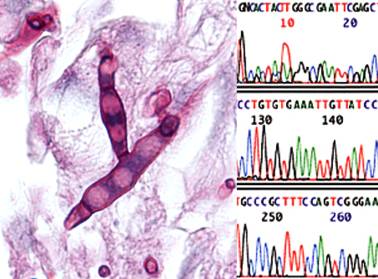 |
|
Pulmonary lesion caused by Fusarium species. Invasive fungal infections are rapidly and accurately identified from fresh and formalin-fixed tissue by ribosomal RNA gene sequencing. |
|
Mycology
Routine fungal cultures: Using special media, including chromogenic agars for yeast identification and our in-house developed potato agar, we can recover most pathogenic fungi from clinical specimens.
Yeast and mould identification:
Moulds are identified based on visual morphology, growth temperature, enzymatic capabilities, and other characteristics. Clinically important fungi that are not identifiable by phenotypic methods are identified by ribosomal RNA gene sequencing. Yeasts are identified by morphology and specific biochemical and assimilation tests.
Molecular Mycology:
When conventional mycology fails to diagnose an infection or when a quicker diagnosis is needed, molecular biology tools such as PCR and ribosomal RNA gene sequencing are applied directly to the original sample or culture to make an accurate diagnosis.
Yeast MIC susceptibility testing: Using a broth microdilution method, yeast susceptibilities are performed for amphotericin, fluconazole, itraconazole, voriconazole, and caspofungin. Blood isolates are tested automatically and others by request.
Mould MIC susceptibility testing: Using a broth microdilution method, mould susceptibilities are performed by request.
Comments regarding fungal susceptibility

